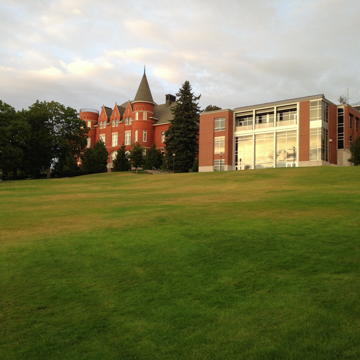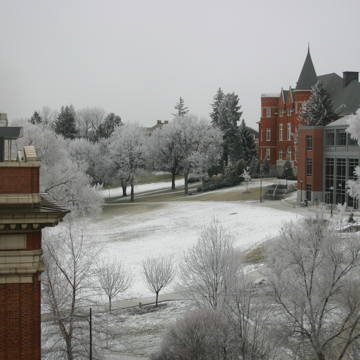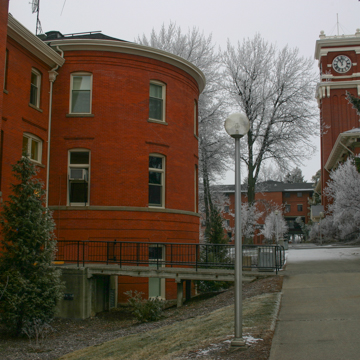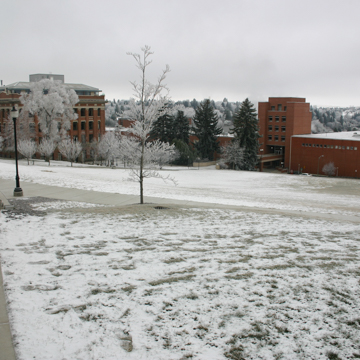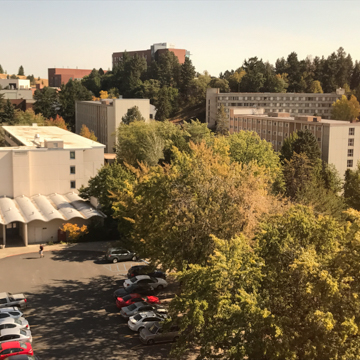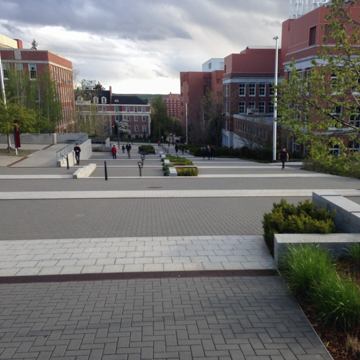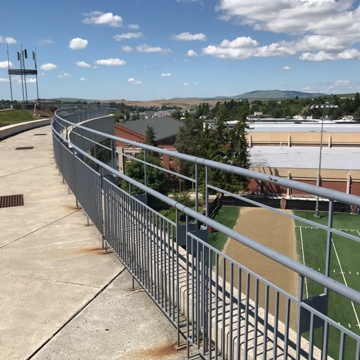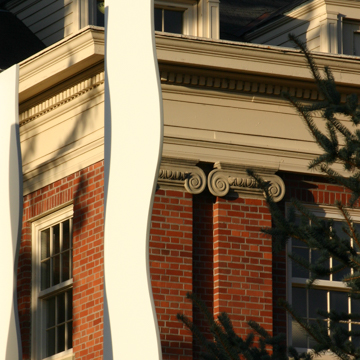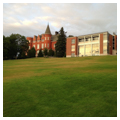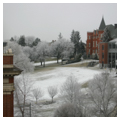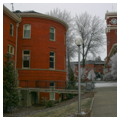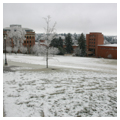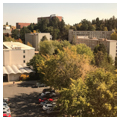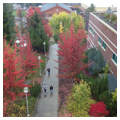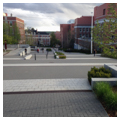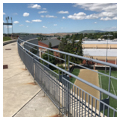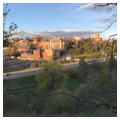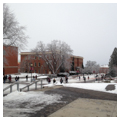You are here
Washington State University
The Washington State University (WSU) campus rises above the small city of Pullman within the vast rolling topography of eastern Washington, its predominantly red brick palette and restrained revival styles marking one of the oldest land grant institutions in the American West. Despite over 125 years of development, the university’s built environment is largely cohesive and features a definitive early core; its buildings are mostly unimposing and in concert with their natural and artificial landscape. The campus has changed over time due to shifting institutional priorities and national directions in design, yet the remote, rural university remains deeply connected to the land and locality in which it sits.
WSU began in 1890 as the Washington State Agricultural College and School of Science: the state’s recipient of the federal land grant established by the Morrill Act of 1862. This grant provided each state in the union with 30,000 acres of land dedicated originally to providing instruction in agriculture and the “mechanic arts” in order to promote the “liberal and practical education of the industrial classes in the several pursuits and professions in life.” In effect, the act set in motion the establishment of colleges whose focus would be on the technical and professional fields—without abandoning a broad classical education.
Establishing a college at all in the remote, southeastern corner of the state of Washington would nonetheless be a challenge. The town of Pullman itself was not platted until 1881, there were no towns of a sizable population located within 75 miles in any direction, and rail connections to the outside world did not exist until 1885. Yet Pullman was surrounded by productive agricultural land, mostly planted for wheat, to which city boosters allegedly pointed so as to convince a traveling band of state commissioners in 1888 to select the 160 acres just east of the town site for Washington’s new land grant institution. The college was established by the state legislature in March 1890 and opened in January 1892.
The college’s early brick buildings for academic instruction, research, administration, and residence rose near the apex of a mostly barren hill more than a quarter-mile east of Pullman’s main street and up a considerable incline. The earliest of these, a quickly erected one-story structure affectionately known as the “Crib” (1892, demolished 1947), contained all of the classrooms, laboratories, and offices for an inaugural class of 59 students. Its broad entrance gable and segmented arched windows did little to overcome its severity and resemblance to a one-room schoolhouse in a frontier town (which, for all intents and purposes, late-nineteenth-century Pullman resembled—or was). Yet most of the college’s new three- to four- story buildings were erected with greater aspirations towards permanence and pretension. Although they were placed upon a steep hillside with no obvious pattern, their facades, entrances, and pathways were oriented west towards downtown, and their brick and stone materials, steeply pitched roofs, and collection of turrets, chimneys, cupolas, arches, and gables contrasted sharply with the humble and scattered dwellings, barns, and businesses in the city below. The college’s built environment was not extravagant, but its hillside setting and handful of architect-designed, red brick buildings established a notable, and noticeable, presence.
Had the college’s Board of Regents gotten its wish, an overly fanciful, more than 400-foot-long, five-story, multipurpose building featuring a central tower and medieval details would have dominated the hillside in the late nineteenth century, sending the institution’s architecture hurtling down a rather unmanageable path towards architectural excess. Legislative funding never materialized for this building, which President Enoch A. Bryan in 1892 considered “wholly visionary and impractical” based upon his impression of a drawing by H. Preusse, the first campus architect and perhaps its first planner as well; erecting such an edifice would have cost five times the entire state appropriation for construction at the college in 1893. The Board of Regents, college administrators, and architects were compelled to settle instead on a series of moderately substantial, mostly eclectic designs during the formative years of campus development, which stretched from 1890 through the late 1930s. Landscaping, trees, fields, pathways, benches, and quadrangles created by building enclosures gradually filled in the otherwise stark environment and produced a distinguished setting for higher education.
The college’s first decade was not lacking for moments of design distinction, however. The college’s administration building (now Thompson Hall), completed in 1894 and designed by Stephen and Josenhans of Seattle following a national competition, remains among the university’s most iconic structures: its asymmetrical massing, pointed arches, and conical turret likening it to a medieval estate in the Loire Valley of France. The no-longer extant Gymnasium, Armory, and Temporary Union Building (1901, demolished 1954) featured a stylistic mix of Romanesque and Norman Gothic; its recessed round arch entrance and series of buttresses along its southern facade supported an expansive interior with exposed wood trusses capped with a gambrel-style roof—an agricultural cathedral.
For the most part, however, the buildings of the early years include architectural references to the western tradition, yet with largely restrained details. Their principal exterior features were volumetric or isolated to one or two elements, whether the arched sandstone entrance of Science (now Murrow) Hall or the classical portico and cupola atop the “new” Ferry Hall (1900; demolished 1975). These buildings were generally outfitted with interiors suited to their needs (whether classrooms, laboratories, lounges, offices, bedrooms, or eating areas) but in general were intended to be more functional than grand. In authorizing funding for Science Hall in 1896, the Board of Regents insisted that costs could be managed “if built plainly and substantially and designed rather for use than for ornament.” Helping circumvent major expenses for the extraction, purchase, and transport of materials for early campus construction, clay deposits on the college grounds permitted the local manufacture of brick and a nearby sandstone quarry was frequently mined as a substitute for more distinguished granite.
Some budget management may have emerged out of sheer necessity; new buildings at the college were fairly expensive due to Pullman’s isolated location and the general difficulty of hauling building materials—and people—to the area. Moreover, the buildings took some time to erect and even longer before landscaping (including trees, walks, and drives) received funding allocations or took effect. Yet even with regularly tight budgets, construction proceeded apace. President Bryan, who authorized many of the new buildings and had considerable influence on architect selection and design details, requested that photographs of buildings distributed for promotional purposes be altered to hide “the piles of tile and sidewalk and lumber and rubbish” as well as the “unsightly telephone poles.” Visiting the campus in the late nineteenth century would have meant stepping into something of a construction zone as the college attempted to keep up with the growing research productivity of its faculty and the rising enrollment of its students.
By the turn of the twentieth century, enrollment levels and the variety of offerings had increased enough to merit a name change for the college, and in 1905 the institution officially became the “State College of Washington,” or Washington State College (WSC). Another building program ensued shortly thereafter that would extend through World War I and the Great Depression, although state legislative appropriations for new construction at WSC was difficult to obtain in full. This period nonetheless saw the construction of Bryan Hall to house the college library, assembly hall, and clock tower; the emergence of Rudolph Weaver as a notable early campus architect with designs for Carpenter Hall, Wilson Hall, and the President’s House; several designs by university architect Stanley Smith including White Hall, Bohler Gymnasium, and the Women’s Physical Education Building (now Smith Gymnasium); and the much-needed construction of several new residence halls, which helped establish the red brick appearance for the campus core. This collection of buildings inspired the writers of Washington: A Guide to the Evergreen State to declare in 1941 that the campus features “several large, modern red-brick buildings, grouped in harmony with a landscape of park-like woods, flower-bordered walks, and spacious lawns.”
Most of these “modern” buildings were designed with reference to the Georgian Revival or Renaissance Revival, while many of the residential halls, in particular, were financed on a “Self-Amortization” plan that permitted construction even with reduced state appropriations. The Self-Amortization plan, crafted by then President Ernest Holland in conjunction with Regent Robert McCroskey and Bursar W.C. Kruegel, permitted community members to buy stock in a “Community Development Corporation,” which then sold bonds for the construction of residential halls in the 1920s and 1930s. Once the residential halls were built, the college then leased the spaces from the corporation for a fixed period with a set rate that included all principal and interest until the bonds were paid—after which the buildings became college property. Although the plan had little influence on residence hall design, it nonetheless set a nationwide precedent for financing new construction. Community Hall, Stimson Hall, Commons, Duncan Dunn Hall, Waller Hall, and Wilmer-Davis Hall were all constructed under the Self-Amortization community-based financing model, which tightened the connection between the campus and the city of Pullman. The model also helped sustain campus construction through the Great Depression, as enrollment grew from 3,270 students in 1930 to 4,035 in 1940, despite dropping to 2,595 in the fall of 1933.
The largest campus expansion followed World War II. At this time, the GI Bill permitted thousands of returning veterans to take advantage of higher learning opportunities not previously available to them and enrollment grew to 5,907 by 1945 to 6,770 in 1946—and rose steadily thereafter. To house these students and provide them with an array of educational opportunities necessitated a construction boom, which did not slow substantially until the early 1970s. Beyond temporary housing supplied by the federal government and academic buildings hastily erected in the wake of campus growth following World War II, many new buildings during the period from the late 1940s through the 1970s mirrored nationwide turns towards architectural modernism and borrowed loosely from the anti-monumental, abstract, stripped-down, asymmetrical vocabulary of the European architectural avant-garde.
With some notable exceptions, such as Paul Thiry’s International Style designs for the Regents Hill residential halls in the late 1950s, much modernist construction still maintained a distinctive local flavor, where brick or patterned facades provided the dominant effect. Major new academic and administrative buildings in the center of campus in the late 1940s and early 1950s, such as Todd Hall, Holland Library, and the Compton Union Building (CUB), were all designed by architect John Maloney and blended modernist volumes and concrete with a brick palette, rich materials, and lavish interior details befitting an aspiring research institution. A small handful of new buildings featuring off-white, crushed-rock, cast-panel facades, such as Johnson Hall, Heald Hall, and Cleveland Hall, diverged slightly from the university’s red brick tradition—their designs attempting to showcase architectural flair through dramatic staircases or glass entryways.
But much campus construction, even in the immediate post–World War II era, retained some connection to historic context or local conditions. The early 1970s work of architect Fred Bassetti at WSU, which includes Avery Hall and Daggy Hall, for example, attempted to blend with the surrounding context through brick facades and modest scale, even if internal organization and circulation catered more to architectural whimsy than academic utility. Kirk, Wallace and McKinley’s French Administration Building was built to house the university’s administration in the late 1960s, yet its patterned brick and sunken landscaping seemed to soften its otherwise bureaucratic function. Walker and McGough’s Stephenson Residence Complex appears rather imposing from afar, although its three red brick towers are far more cohesive, and linked through landscaping, upon closer inspection.
There were major institutional changes to the university during this period, however, and these changes gradually had an effect on the built environment. Between the mid-1940s and early 1970s, the college had grown into a substantial research institution with graduate programs, new degree offerings, and partnerships with major corporations and the federal government, and it required several new science, engineering, and laboratory buildings to facilitate research and new residential space to house an ever-expanding student population. Design direction and campus construction by this time had moved under the auspices of a “College Architect,” a position which had existed as early as 1911 but assumed its current form in the post–World War II years—as an office with an administrative staff (today this office includes designers, engineers, planners, contractors, and maintenance services operating under the university’s Division of Finance and Administration). Reflecting its growing status and size, in 1959, what had been “Washington State College” was renamed “Washington State University” by the state legislature.
By 1970, with student body numbers reaching 14,520 and much new development stretching away from the traditional campus core along the principal loop road known as Stadium Way, a handful of predominantly concrete buildings with Brutalist overtones were rising to accommodate the growing institution, their facades and programs reflecting a general push for efficiency and function over ornament or context. These buildings included the Rogers and Orton residential halls; the Beasley Performing Arts Coliseum, the Fine Arts Center, and the Webster Physical Sciences Building—structures that featured some expressive architectural touches common to their time but few distinctive characteristics that would tie them to the locality beyond spectacular views offered from their uppermost floors. Only a handful of such buildings were constructed on campus, however, and most were on the edges of the historic core. Today, they appear more as anomalies than as precedent-setting examples that urged the campus in a new direction.
That the modern, Brutalist buildings did not dominate or substantially reconfigure the campus does not reduce their significance, however: they were vital structures built to house the functions of the modern institution, designed by well-respected regional architectural firms, and representative of an era filled with optimism about the facilities and spaces deemed necessary to define a top-tier institution. It was also during this time that the newly formed University Planning Council worked to better define the physical grounds of campus by restricting private automobiles from the center (the area bounded by Stadium Way, Spokane Street, and Colorado Street). Today, most of the grounds are reserved for pedestrians, and the Glenn Terrell Pedestrian Mall defines a vital central spine at the top of campus.
The rising importance of intercollegiate athletics at WSU meant also the continual upgrade of the university’s sports facilities on the northeastern edge of campus in the post–World War II years. A suspected 1970 arson fire that destroyed the south grandstand at Rogers Field, the setting both for football and track and field, serves as a symbolic moment in the university’s efforts to accelerate this process. More attention was paid to the functional necessity of such facilities in the latter part of the twentieth century than to architectural extravagance: Rogers Field received immediate upgrades in 1972, 1975, and 1979 to accommodate a growing football fan base and a desire to maintain pace with related facilities at other major universities. In 1980, a new track and field facility, Mooberry Track, opened just to its north, encompassing both the site of the former Bailey baseball diamond and the picturesque, shallow “Silver Lake,” where a cluster of trees, shrubs, pathways, and a rustic bridge had characterized the bucolic eastern edge of campus from 1892 to the 1920s. A small number of new, high-tech laboratory buildings for engineering, sciences, and the veterinary school (including Eastlick Hall, Fulmer Synthesis, and Bustad Hall) rose in the late 1970s and 1980s; their mechanistic guises offest by red brick cladding, scale, or massing that kept them in concert with their physical surroundings.
A building signaling one vision of the university’s architectural future arrived in 1989, when a former beef cattle barn, built in 1925, was repurposed as the Lewis Alumni Centre on the eastern side of campus. In addition to foreshadowing a planned expansion of the university—reinforced by the 2012 master plan update showing physical development extending all the way to a new, grand entrance on Grimes Way and Terre View Drive on the eastern edge of campus—the building’s rehabilitation, undertaken by the Northwest Architectural Company, suggested a larger design turn to existing resources and a recognition of regional traditions. In the early 2000s, the former Livestock Judging Pavilion just northwest of the alumni center was transformed into a multipurpose event space and re-dedicated as the Ensminger Pavilion. Several aspects of the CUB (1952) were retained by Pfeiffer Associates in their 2005 renovation of Maloney’s original building, achieving the university’s first LEED certification in the process; and—although the interior was completely reconfigured—the red brick, Renaissance Revival south entrance facade of Julius A. Zittle’s Troy Hall (1926), the old dairy science building, was left intact when the building was upgraded for modern-day laboratory use in 2017. In the case of the eye-popping, amenity-filled Student Recreation Center (a student-funded building on the cutting edge of such facilities when it was completed in 2000), the stylistic nod was to the university’s agricultural tradition. Designed by Yost Grube Hall, the building’s several gambrel-like roofs were meant to resemble the roofs of barns characteristic of the rural landscape of eastern Washington.
Most important to WSU, of course, was that new or repurposed buildings would attract and serve an ever-increasing student body population, which in Pullman had expanded to 15,864 by the turn of the millennium and to 20,043 by 2017. Capital budget appropriations have been on a long-standing decline, but building campaigns continued under President Elson S. Floyd, whose legacy will include a housing plan by Mahlum Architects, which envisioned several new residences that will transform the university’s midcentury modernist housing legacy on the northeast side of campus. Two of these—the Northside Residential Hall and the Global Scholars Hall, both designed by Genus Architecture—have been completed, their generous lobby spaces and outdoor courtyards reflecting contemporary residence hall design and their variegated facades offering architectural variety.
The longstanding importance of athletics (and particularly football) to the institution is suggested by major alterations to Martin Stadium since 2000, including a new entrance along Stadium Way; and ALSC Architects’ five-story addition containing club suites, a club room, and a press box as well as a high-performance training center or “operations” building. New buildings and spaces on campus typically retain a red brick palette, but eye-catching designs seem more common than those for which contextual sensitivity is the primary driver.
The university has also advanced an integrated delivery system for all new construction, which is intended to be resource-conscious as well: new buildings typically feature materials, systems, orientation, and landscaping optimized to reduce energy, save water, increase natural daylight, and improve human health. At least since 2010, teams of contractors, architects, civil engineers, mechanical engineers, electrical engineers, landscape architects, and others have been invited to bid for (and complete) projects together, thereby reducing time-to-construction and ushering in a new era where all members of the project are ostensibly invited to participate equally in the design and construction process. Several new buildings have resulted from this arrangement, including that for the Brelsford WSU Visitor Center (2014), whose glue-laminated beams and cross-laminated timber ceiling were manufactured based upon research conducted at the university’s own Composite Materials and Engineering Center; whose landscaping (and information panels) inform visitors about native vegetation and stormwater mitigation; and whose large concrete letters spelling “WSU” greet drivers as they pass by. The new Elson S. Floyd Cultural Center (2017) at the northwestern intersection of Stadium Way and State Route 270 also was erected under this model; it is intended to provide a student gathering space honoring all cultures that have made a significant imprint on the state, while its sculptural, wavy roof pays homage to the undulating landscape of the surrounding Palouse region. To note that Olson Kundig or GGLO Design were the lead architects on these two projects, respectively, may be not be any more crucial to their outcome than the numerous other players crucial to their execution.
Indeed, the legacy of these buildings and others at WSU may not be ultimately measured in their delivery method, sculptural shapes, energy savings, or the reputation of their designers. Rather, it may rely upon their ability to uphold the university’s commitment to its land-grant tradition, to reinforce the long-standing connections between the “town” of Pullman and the “gown” of WSU, and to attract an increasingly global population to one of the more remote areas for higher education in the United States. It may also rely upon its ability—no matter the design—to underscore the WSU’s relationship to its community, to its region, and to the land.
References
“Architect Reveals Designs for Administration Building.” Daily Evergreen (Washington State University, Pullman, WA), November 3, 1965.
Bond, Trevor. “Vanished Places: Silver Lake and the Tanglewood.” Washington State Magazine, Spring 2008.
Brailsford & Dunleavy and Opsis Architecture. “University Recreation Development Plan Prepared for Washington State University.” May 2014. Accessed January 14, 2017. https://urec.wsu.edu/.
Bryan, Enoch Albert. Historical Sketch of the State College of Washington, 1890-1925. Spokane, WA: Inland-American Printing Co, 1928.
“Building Program for 1950 Set; WSC to Grow.” Alumni Powwow, Washington State College 30, no. 5 (February 1, 1950).
Clark, Larry. “Opening New Doors to Green.” Washington State Magazine, Winter 2009.
Clark, Larry, and Hannalore Sudermann. “A Building is ‘Re-Barn’: Architect Robert Grossman ’59 and the Lewis Alumni Centre.” YouTube video. WSU Magazine, August 22, 2014. https://www.youtube.com/.
“Dormitory Rooms: Planning for Maximum Spaciousness with Minimum Space.” Architectural Forum: The Magazine of Building 95, no. 9 (1951): 174-177.
Ferguson, Will. “Oct. 24: WSU Celebrates Tallest Building’s Long Legacy.” WSU News, October 20, 2014.
Fry, Richard B. The Crimson and the Gray: 100 Years with the WSU Cougars. Pullman: Washington State University Press, 1989.
Frykman, George A. Creating the People’s University: Washington State University, 1890-1990. Pullman: Washington State University Press, 1990.
Gonzalez, J. Misha. “A Laboratory for Gracious Living.” Honors Thesis, Washington State University, 2013.
Halverson, Mark. “Schooling the Visitor: Exposed Glulam and Other Engineered Wood Products Help WSU Tell Its Technology Story.” Building Design + Construction,November 20, 2015.
Hanbury Evans Wright Vlattas and Company. Pullman Campus Master Plan Update: 2012. Vol. 2. Washington State University, May 2012.
Hannum, Erle. “‘New Dorm,’ Officially Titled. Will Be ‘Fred S. Stimson Hall’.” The Evergreen (Washington State College, Pullman, WA). April 23, 1924.
Hilding, Tina. “PACCAR Environmental Technology Building Dedicated.” WSU News, May 6, 2016. Accessed January 15, 2017.
Hill, John. “Brelsford WSU Visitor Center.” World Architects-Review. Accessed January 15, 2017. http://www.world-architects.com/.
Hinojosa, Elena. “Seven Rec Center Committee Members to See Other Centers.” WSU Daily Evergreen (Washington State University, Pullman, WA), December 11, 1997.
Historic Resource and Survey Analysis: The Report of the Task Force for Historic Preservation on the Historic Core of the Washington State University Campus. Pullman, WA: Task Force for Historic Preservation, February 12, 1985.
Hoffman Construction. “At Home in New Facilities, WSU Cougars have High Hopes for the Upcoming Football Season.” Skyline, September 2015.
“‘Hub of Student Life’ Will Change Campus Culture.” WSU Hilltopics, March 2001.
Krafft, Katherine Hills. “James Stephen.” In Shaping Seattle Architecture: A Historical Guide to the Architects, edited by Jeffrey Karl Ochsner, 88-93. 2nd ed. Seattle: University of Washington Press, 2014.
Landeen, William M. E. O. Holland and the State College of Washington, 1916-1944. Pullman: State College of Washington, 1958.
“Landscaping in Progress for French Ad. Building.” Daily Evergreen (Washington State University, Pullman, WA), May 10, 1968.
Luedeking, Robert. Images of America: Pullman.Whitman County Historical Society. Charleston, SC: Arcadia Publishing, 2010.
Mahlum Architects. Executive Summary: Long-Range Housing Plan. Washington State University, September 2010. http://facilitiesservices.wsu.edu/.
McDonald, Adrian. “WSU’s PACCAR Building Houses 5 R&D Labs.” Seattle Daily Journal of Commerce, November 19, 2015.
Morgan, Vera, “Stevens Hall, Washington State University,” Whitman County, Washington. National Register of Historic Places Inventory–Nomination Form, 1978. National Park Service, U.S. Department of the Interior, Washington, D.C.
Neil, J. Meredith. “Administrators, Architects, and Campus Development: Washington State University, 1890-1905.” Journal of the Society of Architectural Historians 20, no. 2 (May 1970): 144-155.
“New Education Building Under Final Construction.” Daily Evergreen (Washington State University, Pullman, WA), October 17, 1963.
“New Women’s Dormitory Being Completed for Opening this Fall.” Alumni Powwow¸ Washington State College 31, no. 10 (July 1951): 7.
“Old-Style Prison.” Daily Evergreen (Washington State University, Pullman, WA), May 26, 1967.
“Olympia Housing Wins Best Student Housing Award.” WSU News, June 21, 2010.
“Physical Sciences Building: New 16-Story Structure Dominates Skyline.” WSU Hilltopics, March 1974.
Quinn, Shannon. “WSU Unveils its Green Masterpiece.” Moscow-Pullman Daily News, May 7, 2016. Accessed January 15, 2017.
Rash, David A. “Connections by Weaver.” Paper delivered at the annual conference of the Marion Dean Ross/Pacific Northwest Chapter of the Society of Architectural Historians, University of Idaho, Moscow, Idaho (September 16, 2006). Original paper held in the Marion Dean Ross Chapter of the Society of Architectural Historians Records, Special Collections and University Archives, University of Oregon Libraries, Eugene, Oregon.
Rash, David A. “Carpenter Hall at Washington State University.” Arcade: The Northwest Journal for Architecture and Design 12, no. 4 (August-September 1991): 6-10.
“Rec and Effect.” School Construction News, December 10, 2005.
“Regents' Hill to Open; Co-eds Move Saturday.” Daily Evergreen (Washington State College, Pullman, WA), April 17, 1952.
Schank, Amanda. “Iconic Gateway: Sellen and Olson Kundig Team Up to Build a New Front Door for the WSU Campus.” Craft 3 (Summer 2014): 7-9.
Staley, David P. “A W.S.U. Heritage: The Ethnoarchaeology of the Beef Cattle Barn.” 1987?. In WSU Historic Buildings Information. Vols. 1 and 2. Compiled for the use of Architecture 424, Washington State University, Spring 1993. Washington State University Libraries, Manuscripts, Archives, and Special Collections, Pullman, WA.
Stimson, William L. Instilling Spirit: Students and Citizenship at Washington State, 1892-1942. Pullman: Washington State University Press, 2015.
Stimson, William L. Going to Washington State: A Century of Student Life. Pullman: Washington State University Press, 1989.
Stratton, David H., “Albert W. Thompson Hall, Washington State University,” Whitman County, Washington. National Register of Historic Places Inventory–Nomination Form, 1972. National Park Service, U.S. Department of the Interior, Washington, D.C.
Sudermann, Hannalore. “Outside-In: The Architecture of the Pacific Northwest.” Washington State Magazine (Spring 2011).
Terrell, Glenn. The Ministry of Leadership: Heart and Theory. Seattle: Pacific Institute Publishing, 2002.
Van der Veen, Ron, and Gabriela Frank. “In New WSU Dorm, Each Floor is a Neighborhood.” Seattle Daily Journal of Commerce, November 18, 2010.
Vogt, Andrea. “The Lure.” Washington State Magazine, Winter 2003.
“Washington State University Buildings – History.” Manuscripts, Archives, and Special Collections, Washington State University Libraries, Pullman, Washington.
“Washington State University Student Recreation Center.” Yost Grube Hall. Accessed January 14, 2017. http://ygh.com/.
Woodbridge, Sally B., and Roger Montgomery. A Guide to Architecture in Washington State: An Environmental Perspective. Seattle: University of Washington Press, 1980.
Writers’ Program of the Work Projects Administration in the State of Washington. Washington: A Guide to the Evergreen State. Portland, OR: Binfords and Mort, 1941.
WSU Historic Buildings Information. Vols. 1 and 2. Compiled for the use of Architecture 424, Washington State University, Spring 1993. Washington State University Libraries, Manuscripts, Archives, and Special Collections, Pullman, Washington.
Writing Credits
If SAH Archipedia has been useful to you, please consider supporting it.
SAH Archipedia tells the story of the United States through its buildings, landscapes, and cities. This freely available resource empowers the public with authoritative knowledge that deepens their understanding and appreciation of the built environment. But the Society of Architectural Historians, which created SAH Archipedia with University of Virginia Press, needs your support to maintain the high-caliber research, writing, photography, cartography, editing, design, and programming that make SAH Archipedia a trusted online resource available to all who value the history of place, heritage tourism, and learning.




















